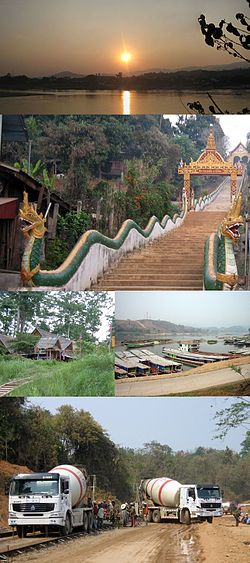Bokeo Province
Bokèo (Laotian: ບໍ່ແກ້ວ;)[1] is a northern province of Laos. It has the fewest people. Bokeo Province is the smallest of the country's provinces, covering an area of 6,196 square kilometres (2,392 square miles).
Bokeo
ບໍ່ແກ້ວ | |
|---|---|
 | |
 Map of Bokeo Province | |
 Location of Bokeo Province in Laos | |
| Coordinates: 20°18′00″N 100°25′01″E / 20.3°N 100.417°E | |
| Country | |
| Capital | Ban Houayxay |
| Area | |
| • Total | 6,196 km2 (2,392 sq mi) |
| Population (2005 census) | |
| • Total | 145,263 |
| • Density | 23/km2 (61/sq mi) |
| Time zone | UTC+07 |
| ISO 3166 code | LA-BK |
History
changeBokeo ("gem mine") was named after the sapphires gems that is found in the province.[2]
Geography
changeBokeo Province is the smallest of the country's provinces,[3] covering an area of 6,196 square kilometres (2,392 sq mi).[4]
Protected areas
changeThe Bokeo Nature Reserve was created as protection for the black crested gibbon (also known as "black-cheeked gibbon"), discovered in 1997, previously thought to be extinct. Elephants and wild water buffalo migrate through the reserve;[5] bears and tigers are also present.[6]
Other than the gibbons the wildlife in the reserve reported are: tigers, bears, otters and wild cattle.
Demographics
changeIts population was 145,000 in 2007,[1] in 36 townships, more than 400 villages.[7] The province has more than 34 ethnicities.
Economy
changeHouay Xay, the capital city of the province, has a lot of eco nomic activity. The province produces a lot of maize.[8] Also there is a big industry for precious stones and gold
Paa beuk, a catfish, the largest freshwater fish in the world, is found in the Mekong river. It grows to 3 metres (9.8 ft) in length and could weigh up to 300 kg. It is an economic resource for the people as it has a high price in the market, the meat of this endangered fish being a delicacy.
Gallery
change-
Houayxay centre
-
Wat Jom Khao Manilat
-
Village on the Mekong River
-
In a Khmu village
References
change- ↑ 1.0 1.1 Burke & Vaisutis 2007, p. 214.
- ↑ Bush, Elliot & Ray 2010, p. 172.
- ↑ "Home". Regions. Official website of Laos Tourism. Archived from the original on 13 May 2013. Retrieved 7 January 2013.
{{cite web}}: More than one of|archivedate=and|archive-date=specified (help); More than one of|archiveurl=and|archive-url=specified (help) - ↑ "Bokeo Province". Lao Tourism. Archived from the original on 13 May 2013. Retrieved 1 December 2012.
{{cite web}}: More than one of|archivedate=and|archive-date=specified (help); More than one of|archiveurl=and|archive-url=specified (help) - ↑ DK Publishing 2011, p. 183.
- ↑ Outlook Publishing 2008, p. 58.
- ↑ "Destination: Bokeo Province". Laos Tourism Organization. Archived from the original on 13 May 2013. Retrieved 30 November 2012.
{{cite web}}: More than one of|archivedate=and|archive-date=specified (help); More than one of|archiveurl=and|archive-url=specified (help) - ↑ Lao People's Democratic Republic: Second Poverty Reduction Strategy Paper (EPub). International Monetary Fund. 21 October 2008. p. 54. ISBN 978-1-4527-9182-1. Retrieved 6 December 2012.
Bibliography
change- Burke, Andrew; Vaisutis, Justine (1 August 2007). Laos 6th Edition. Lonely Planet. pp. 214–. ISBN 978-1-74104-568-0.
- Bush, Austin; Elliot, Mark; Ray, Nick (1 December 2010). Laos 7. Lonely Planet. pp. 172–. ISBN 978-1-74179-153-2.
- Burton, John J. S. (2005). Lao close encounters. Orchid Press. p. 149. ISBN 978-974-524-075-9. Retrieved 4 December 2012.
- DK Publishing (1 July 2011). DK Eyewitness Travel Guide: Cambodia & Laos: Cambodia & Laos. Penguin. pp. 183–. ISBN 978-0-7566-8426-6.
- Geological Survey (U S ) (25 October 2010). Minerals Yearbook: Area Reports: International 2008: Asia and the Pacific. Government Printing Office. pp. 14–. ISBN 978-1-4113-2964-5.
- Levinson, David; Christensen, Karen (2002). Encyclopedia of modern Asia. Charles Scribner's Sons. p. 304. ISBN 978-0-684-31242-2.
- Outlook Publishing (March 2008). Outlook Traveller. Outlook Publishing. pp. 58–.
- White, Daniel (1 March 2010). Frommer's Cambodia and Laos. John Wiley & Sons. pp. 290–. ISBN 978-0-470-49778-4.